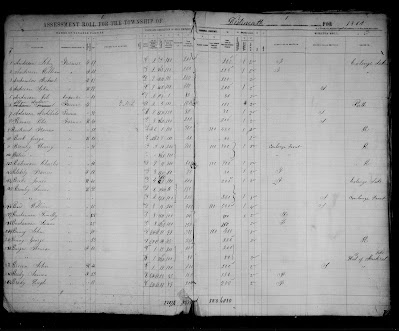A little while back, someone posted a query in one of the Facebook groups that deal in Ontario, Canada genealogy. It was a simple question that was interesting to explore:
"I have a tax assessment roll from 1864 and along with it is a militia roll. Can someone explain what that is please."
When a question like this is posted, I always like to look at the pages and even years before for clues.
I just happened to realize that this image was probably from the assessment rolls made available in a digitized format on FamilySearch. Otherwise, I would have prompted the original poster for the source. I want to reminder folks to always state the source of an image in their queries so that others can also find it and other possible related documents.
What we find for the first page for 1864 assessment of Westmeath Township is a list of names, ages, and details about the property.
That is what I expected to see.
In the 1863 assessment we don't see those Militia columns. So what gives?
Also, what is that "First Class Service", "Second Class Service", and "Reserve"?
Over the past few years I've learned that understanding the law as it has been passed by the various legislatures can often answer many questions when it comes to government created forms.
In this case we need to look at "An Act respecting the Militia", 27 Vict., Cap 2. This act was assented to on October 15, 1863. There we find the definitions for those First Class Service, Second Class Service, and Reserve:
2. The Militia shall consist of all the male inhabitants of the Province of the age of eighteen years or upwards and under sixty, not exempted or disqualified by law.
3. The Militia shall be divided into three classes, to be called respectively first class Service Men, second class Service Men and Reserve Men : the first class Service Men shall be those of eighteen years of age and upwards, but under forty-five years, who are unmarried Men or widowers without children, and the second class Service Men shall be those between the ages last aforesaid who are married Men or widowers with children, — and the Reserve Men shall be those of forty-five years of age and upwards, but under sixty years.
We even find the exemptions in section 4 of the act.
Why, as genealogists and family historians, should we care about these details? Knowing which class a man has been assigned to can provide clues as to their marital status and if they have any children.
But why did we not have these militia columns in previous years?
Well, in section 6 the act states for service enrolment in Upper Canada (section 10 covers Lower Canada):
6. The mode of enrolment of the Militia shall, in Upper Canada, be as follows, that is to say; — the Assessor or Assessors for each Municipality in Upper Canada shall, annually, commencing with the year one thousand eight number and sixty-four, and at the same lime when they are engaged in taking the Assessment of real and personal property in their respective Municipalities, include in their Assessment Roll, the names and residences of all male persons in their respective Municipalities, between the ages of eighteen and sixty years; and they shall prepare three additional columns in such Assessment Roll, which shall be headed respectively "First Class Service Militia Roll,'" "Second Class Service Militia Roll" and "Reserve Militia Roll,"...
So it seems it wasn't until the 1864 assessments that this started.
What we also need to remember is that not every assessor recorded the information the same way on the forms. For the 1864 assessment of the Township of Westmeath, we've already seen that the assessor just wrote a "F", "S", "R", or a place in the columns and added all the men who didn't seem to own land to a separate list.
For the 1864 assessment of the Township of Enniskillen in Lambton County we see that the names are recorded in the columns and there might be more than one name recorded for a property.
So make sure you pay attention to how the assessor actually completed the forms.
Additionally, depending on the assessor, there may be other sorts of information recorded on the forms, especially on the pieces of paper at the end of the assessment rolls. So always check the end of each year's assessment.
Finally, if you want to know which Ontario assessment rolls have been digitized by FamilySearch, there is a simple query you can use to search the FamilySearch Catalog:
 |
| Screen capture of the FamilySearch Catalog search page with titles: assessment, subjects: taxation, keywords: canada ontario, Availability: Online. |
- Titles: assessment rolls
- Subjects: taxation
- Keywords: canada ontario
- Availability: Online
Just keep in mind that not all places will have the assessment rolls on FamilySearch. Many townships and municipalities still have them only available in paper or microfilm format at a local archive or genealogy or historical society. So if you can't find the township listed on FamilySearch then check with the organizations local to that township.



 Back in February 2023 I wrote "
Back in February 2023 I wrote "
